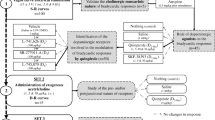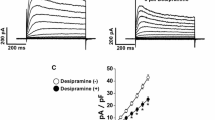Abstract
The release of norepinephrine (NE) from the right atrium of the rabbit heart was used as a model to investigate biphasic effects due to tricyclic antidepressants, similar to those clinically observed in the treatment of depression and known as “therapeutic window”. Strips of the atrium were loaded with3H-NE, and then superfused by Krebs solution. The basal release and the electrical stimulation evoked release of3H-NE were measured in the presence and absence of four clinically used tricyclic antidepressants: imipramine, amitriptyline, desipramine and nortriptyline. In addition, guanethidine, an adrenergic neuron blocker, was also studied. At lower concentrations (0.5–10 µM) tricyclic antidepressants increased, whereas higher concentrations (50–100 µM), inhibited the evoked release of NE. This inhibition was not prevented by the alpha2 adrenoceptor antagonist yohimbine, excluding the possibility of alpha2 adrenoceptormediated inhibition of NE release. In higher concentrations the tricyclic antidepressants increased the basal release of NE in a Ca-independent way. Secondary amine derivatives were more potent inhibitors of the evoked release, and enhance the resting basal release of NE to a greater extent than the tertiary ones. Similarly, guanethidine (1–50 µM) also decreased the evoked release and increased the basal release of NE in a concentration dependent manner. Yohimbine failed to counteract the inhibition caused by guanethidine and the increment of the basal release was Ca-independent. It is concluded that the effect of tricyclic antidepressants in potentiating the release of NE is masked by their adrenergic neuron blocking properties, i.e. they inhibit the release of NE. Our findings are consistent with paradoxical clinical observations that some tricyclic antidepressants have therapeutic value only in lower plasma concentrations and they become ineffective at higher concentrations.
Similar content being viewed by others
References
Asberg M, Cronholm B, Sjöqvist F, Tuck D (1971) Relationship between plasma level and therapeutic effect of nortriptyline. Br Med J 3:331–334
Baldessarini RJ (1985) Drugs and the treatment of psychiatric disorders. In: Gilman AG, Goodman LS, Rall TW, Murad F (eds) Goodman and Gilman's The pharmacological basis of therapeutics, 7th edn. MacMillan, New York, pp 387–445
Bennet JF (1967) Is there a superior antidepressant? In: Garattini S and Dukes MNG (eds) Antidepressant drugs. Excerpta Medica International Congress Series No 122, Amsterdam, pp 375–393
Bickel MH, Weder HJ (1968) The total fate of a drug: kinetics and distribution, excretion and formation of 14 metabolites in rats treated with imipramine. Arch Int Pharmacodyn 173:433–463
Biegon A, Samuel D (1979) The in vivo distribution of an antidepressant drug in male and female rats. Psychopharmacology 65:259–263
Boyer WF, Lake CR (1987) Initial severity and diagnosis influence the relationship of tricyclic plasma levels to response: a statistical review. J Clin Psychopharmacol 7:67–71
Brodie BB, Chang CC, Costa E (1965) On the mechanism of action of guanethidine and bretylium. Br J Pharmacol Chemother 25:171–178
Christiansen J, Gram LF (1973) Imipramine and its metabolites in human brain. J Pharm Pharmacol 25:604–608
Coryell W, Turner RD, Sherman A (1987) Desipramine plasma levels and clinical response: evidence for a curvilinear relationship. J Clin Psychopharmacol 7:138–142
Costa E, Boullin DJ, Hammer W, Vogel W, Brodie BB (1966) Interactions of drugs with adrenergic neurons. Pharmacol Rev 18:577–597
Eisenhofer G, Ropchak TG, Stull RW, Goldstein DS, Keiser HR, Kopin IJ (1987) Dihydroxyphenylglycol and intraneuronal metabolism of endogenous and exogenous norepinephrine in the rat vas deferens. J Pharmacol Exp Ther 241:547–553
Glassman HA, Perel JM, Shostak M, Kantor SJ, Fleiss LJ (1977) Clinical implications of imipramine plasma levels for depressive illness. Arch Gen Psychiatry 34:197–204
Heikkila RE, Goldfinger SS, Orlansky H (1976) The effect of various phenothiazines and tricyclic antidepressants on the accumulation and release of (3H)-norepinephrine and (3H)5-hydroxytryptamine in slices of rat occipital cortex. Res Commun Chem Pathol Pharmacol 13:237–250
Hertting G, Axelrod J, Whitby LG (1961) Effect of drugs on the uptake and metabolism of3H-norepinephrine. J Pharmacol Exp Ther 134:146–153
Hughes IE (1978) The effect of amitriptyline on presynaptic mechanisms in noradrenergic nerves. Br J Pharmacol 63:315–321
Iversen LL (1965) Inhibition of noradrenaline uptake by drugs. J Pharm Pharmacol 17:62–64
Kragh-Sorensen P, Hansen E, Baastrup PC, Hvidberg EF (1976) Self-inhibiting action of nortriptyline antidepressive effect at high plasma levels. Psychopharmacologia 45:305–312
Lader M (1974) Plasma concentrations of tricyclic antidepressive drugs. Br J Clin Pharmacol 1:281–283
Lindmar R, Löffelholz K, Muscholl E (1969) Unterschiede zwischen Tyramin und Dimethylphenylpiperazin in der Ca++ Abhangigkeit und im zeitlichen Verlauf der Noradrenalin-Freisetzung am isolierten Kaninchenherzen. Experientia 23:933–934
Mandell AJ, Spooner CE, Winters WD, Cruikshank M, Sabbot IM (1968) Neurochemical correlates of the imipramine antagonism of the behavioral effects of norepinephrine. Life Sci 7:1317–1324
Mitchell JR, Oates JA (1970) Guanethidine and related agents. I. Mechanism of selective blockade of adrenergic neurons and its antagonism by drugs. J Pharmacol Ther 172:100–107
Nathan RS, Perel JM, Pollock BG, Kupfer DJ (1990) The role of neuropharmacologic selectivity in antidepressant action: fluvoxamine versus desipramine. J Clin Psychiatry 51:367–372
Paton DM (1973) Mechanism of efflux of noradrenaline from adrenergic nerves in rabbit atria. Br J Pharmacol 49:614–627
Perel JM, Wong SHY (1989) Therapeutic/toxicity tricyclic antidepressant (TCA) plasma level monitoring. Criteria and methodologies. In: Galteau MM, Siest G, Henny J (eds) Biologie Prospective, Compte rendus du 7e Colloque de Pont a Mousson, John Libbey Eurotext, Paris, pp 783–792
Richelson E, Nelson B (1984) Antagonism by antidepressants of neurotransmitter receptors of human brain in vitro. J Pharmacol Exp Ther 230:94–102
Sigg EB, Osborn M, Korol B (1963) Cardiovascular effects of imipramine. J Pharmacol Exp Ther 141:237–243
Somogyi GT, Perel JM (1988) Inhibitory action of some tricyclic antidepressants (TCA) on the presynaptic muscarinic receptors of the adrenergic nerve terminals. Pharmacologist 30:A118
Somogyi GT, Perel JM (1989a) Antagonism by tricyclic antidepressants of the muscarinic receptors located on the adrenergic nerve endings in rabbit heart atrium. J Pharmacol Exp Ther 251:922–928
Somogyi GT, Perel JM (1989b) Biphasic effect of tricyclic antidepressants on the release of norepinephrine (NE) from the adrenergic nerves of rabbit heart. Pharmacologist A120
Sulser F (1984) Mode of action of antidepressant drugs. J Clin Psychiatry 44:14–20
Titus EO, Matusek N, Spiegel HE, Brodie BB (1966) The effect of desmethylimipramine on uptake ofdl-norepinephrine-7-H3 in the heart. J Pharmacol Exp Ther 152:469–477
Vizi ES (1979) Presynaptic modulation of neurochemical transmission. Prog Neurobiol 12:181–290
Vizi ES, Somogyi GT, Harsing LG, Zimanyi I (1985) External Ca-independent release of norepinephrine by sympathomimetics and its role in negative feedback modulation. Proc Natl Acad Sci USA 82:8775–8779
Vizi ES, Somogyi GT, Harsing LG Jr, Zimanyi I (1986) Release of [3H]noradrenaline by alpha1-adrenoceptor antagonists. Neurochem Res 11:71–84
Weiner N (1985) Drugs that inhibit adrenergic nerves and block adrenergic receptors In: Gilman AG, Goodman LS, Rall TW, Murad F (ed) Goodman and Gilman's the pharmacological basis of therapeutics, 7th edn. MacMillan, New York, pp 181–214
Westfall PD (1973) Antagonism by protriptyline and desipramine of the response of the vas deferens of the rat to norepinephrine, acetylcholine and potassium. J Pharmacol Exp Ther 185:540–550
Author information
Authors and Affiliations
Rights and permissions
About this article
Cite this article
Somogyi, G.T., Perel, J.M. Biphasic effect of tricyclic antidepressants on the release of norepinephrine from the adrenergic nerves of the rabbit heart. Psychopharmacology 104, 237–243 (1991). https://doi.org/10.1007/BF02244185
Received:
Accepted:
Issue Date:
DOI: https://doi.org/10.1007/BF02244185




